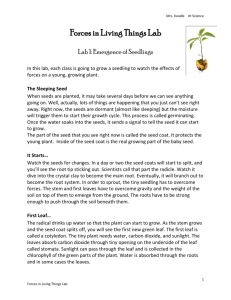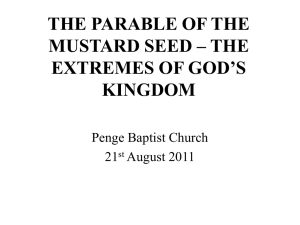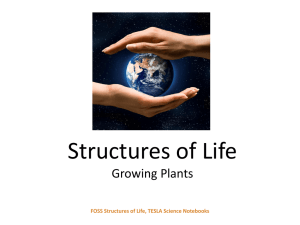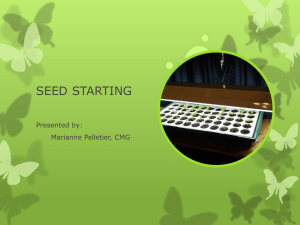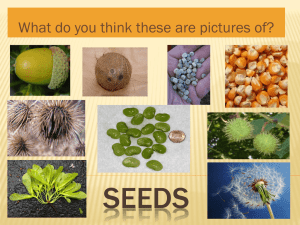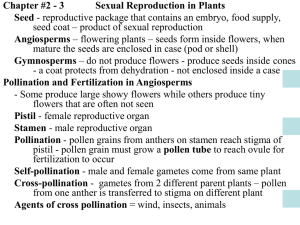Lab 1: Emergence of Seedlings
advertisement
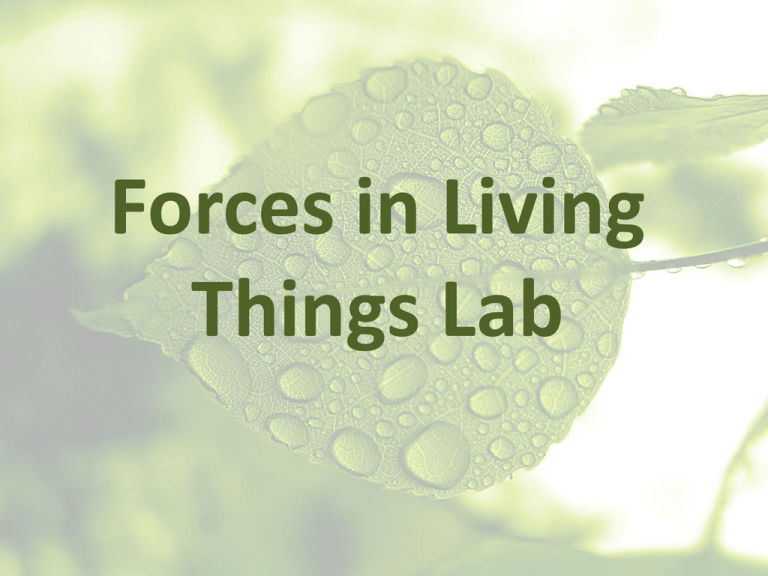
Forces in Living Things Lab • In science, there is a very specific definition for the word “work” • Work only takes place if there is a force and a motion. • If there is a force AND motion, then work has taken place. • As you go through these labs, think about what forces are acting on the plants and if there is any motion. Lab 1: Emergence of Seedlings Lab 1: Emergence of Seedlings In this lab, each class is going to grow a seedling to watch the effects of forces on a young, growing plant. We will read through the information on your lab instructions Lab 1: Emergence of Seedlings The Sleeping Seed When seeds are planted, it may take several days before we can see anything going on. Well, actually, lots of things are happening that you just can’t see right away. Right now, the seeds are dormant (almost like sleeping) but the moisture will trigger them to start their growth cycle. This process is called germinating. Once the water soaks into the seeds, it sends a signal to tell the seed it can start to grow. The part of the seed that you see right now is called the seed coat. It protects the young plant. Inside of the seed coat is the real growing part of the baby seed. Lab 1: Emergence of Seedlings It Starts… Watch the seeds for changes. In a day or two the seed coats will start to split, and you’ll see the root tip sticking out. Scientists call that part the radicle. Watch it dive into the crystal clay to become the main root. Eventually, it will branch out to become the root system. In order to sprout, the tiny seedling has to overcome forces. The stem and first leaves have to overcome gravity and the weight of the soil on top of them to emerge from the ground. The roots have to be strong enough to push through the soil beneath them. Lab 1: Emergence of Seedlings First Leaf… The radical drinks up water so that the plant can start to grow. As the stem grows and the seed coat splits off, you will see the first new green leaf. The first leaf is called a cotyledon. The tiny plant needs water, carbon dioxide, and sunlight. The leaves absorb carbon dioxide through tiny opening on the underside of the leaf called stomata. Sunlight can pass through the leaf and is collected in the chlorophyll of the green parts of the plant. Water is absorbed through the roots and in some cases the leaves. • How does a seed respond to its environment? • What is a push or pull called? • What pushes or pull are involved in a seed growing? Lab 1: Emergence of Seedlings Materials • clear tube or cup • crystal clay • pinto beans • spring water Lab 1: Emergence of Seedlings Procedure 1. Place half a scoop of crystal clay in the cup. 2. Add a small amount of spring water. 3. The crystals will expand as they absorb water. Add water as needed until there is enough to plant a seed in. Lab 1: Emergence of Seedlings Procedure 4. Wait 20 to 60 minutes. If any of the crystals are still exposed above the water line, add more water one teaspoon at a time. Re-Check every 30 minutes and add water as needed until the crystals have stopped expanding. If the crystals reach the top of the tube, remove some until it is no more than ¾ full. If there is too much water, pour some off of the top. 5. Add the beans. Do not bury them and make sure that the water level is high enough to keep the seeds moist, but not soaked, during the first 3 days. Lab 1: Emergence of Seedlings Procedure 6. Put the seed in a bright, cool place. 7. Add water as needed to keep the water level just below the top of the crystals. 8. After 1-2 days, take out any seeds that have not germinated. • Let’s begin filling out the scientific method flow chart. • Observation Describe what the seeds did in the video. The seed sprouted a root and a stem. The root pushed down into the ground and the stem pushed up and out of the ground. • Question What can we ask about this observation? • Hypothesis: Finish this sentence on your scientific method flow chart to describe what you think will happen to the beans: I think the roots will__________,and the stems and leaves will ________________________ . • Predict: Describe what you think will happen during the experiment. During this experiment I think_______ • Plan an Investigation: This has been done for you. • The rest of the flow chart will be completed after the seeds sprout • Label your bean diagram on your lab answer sheet. • Label the diagram of the bean seedling • Questions 1-5 will be answered after the seeds sprout. Lab 2: Geotropism Lab 2: Geotropism In this lab, we will observe how gravity can affect seedling growth. Have you ever wondered how a plant knows which way to grow? Imagine how Earth would look if plants could grow in many different directions. On Earth, a force called gravity signals young seedlings to push their stems up and their roots down. Lab 2: Geotropism Materials • 4 bean seeds • petri dish • tape • cotton balls • tap water Lab 2: Geotropism Procedure 1. Take four soaked seeds, and place them in the bottom of a petri dish with the seed “dimples” facing toward the center. A seed should be placed on the 12, 3, 6 and 9 o’clock positions of the petri dish. Lab 2: Geotropism Procedure 2. Place cotton balls on top of the seeds to hold them in place. 3. Using the spray bottle, dampen the cotton balls. Do not get them so wet that they drip. 4. Carefully cover the seeds with the petri dish lid. 5. Close the petri dish and tape the lid in place. Lab 2: Geotropism Procedure 6. Diagram the petri dish set-up at the beginning of the lab and after the seeds sprout. 7. Write the group member names on a small piece of paper and tape it to the back of the petri dish. 8. Place the petri dished vertically in a dark place such as a closet or cabinet. • This time you will fill in the first 5 boxes of the scientific method flow chart on your own • Hypothesis: How do you think each of the bean seedlings will grow? Write a brief hypothesis on your scientific method chart. Then draw a detailed diagram of your hypothesis on your lab sheet. • Hypothesis: Make sure you diagram the set-up and draw arrows to predict which way the roots and stems will grow for each seed. • The “after” drawing and questions 1-6 will be done after the seeds have sprouted. Lab 3: Turgor Pressure Lab 3: Turgor Pressure In this lab, we will observe how water can affect the rigidity of a plant. We know that plants require sunlight, water and soil to survive. Water is used by the plant for many different purposes. First, water is needed for photosynthesis. Plants also need water to “inflate” their cells and keep the stems and leaves upright. When a plant does not have enough water, it will wilt and droop. If it goes long enough without water the plant cells die. Lab 3: Turgor Pressure The water inside the cell puts pressure on the cell just like water inside a balloon pushes out on the balloon. The pressure that the water exerts is called turgor pressure. High turgor pressure in a plant keeps all of the leaves and stems upright. Low turgor pressure causes the plant to wilt. Lab 3: Turgor Pressure If a plant is placed in salt water, the water inside the cell is pulled out and dehydrates the cell. When placed in fresh water, water can enter the cell. Materials: strips of potato salt water 2 beakers Lab 3: Turgor Pressure Procedure Most of this has been done for you. 1. Soak some strips of potato in salt water. The salt water will cause water inside the plant cells to leave. Lab 3: Turgor Pressure Procedure 1. Soak some strips of potato in fresh water. The fresh water will cause water from outside the cell to go in. Lab 3: Turgor Pressure Procedure Before touching the potato strips, fill out the first 5 boxes on the scientific method flow chart. • Hypothesis: Which potato strip will have high turgor pressure and which one will have low turgor pressure? Write your hypothesis on your scientific method flow chart. Lab 3: Turgor Pressure Procedure 2. Take one potato strip that was soaked in salt water and that was soaked in fresh water. 3. Bend each strip until it breaks. For this experiment, you can go ahead and complete the scientific method flow chart and questions 1-5.
